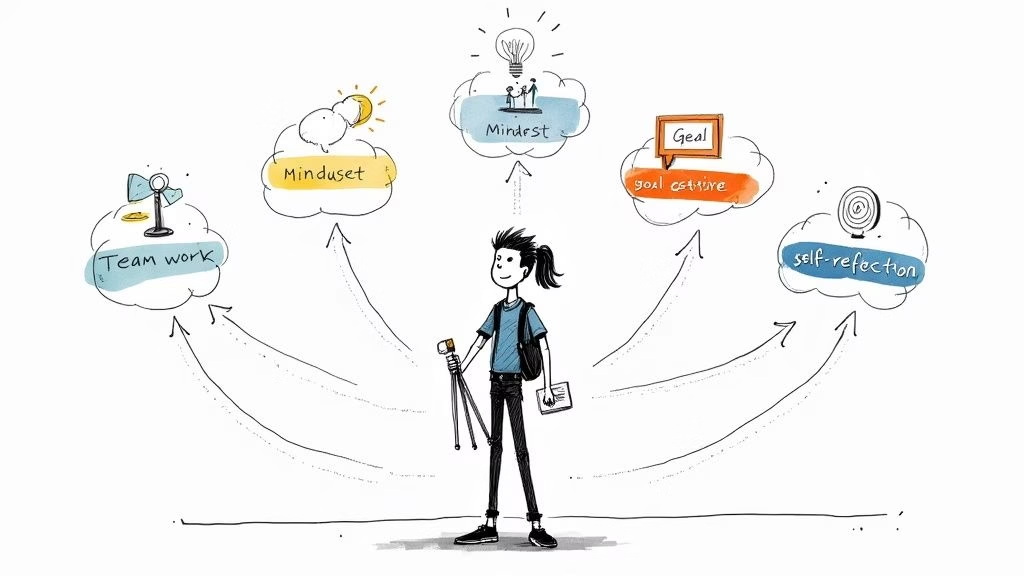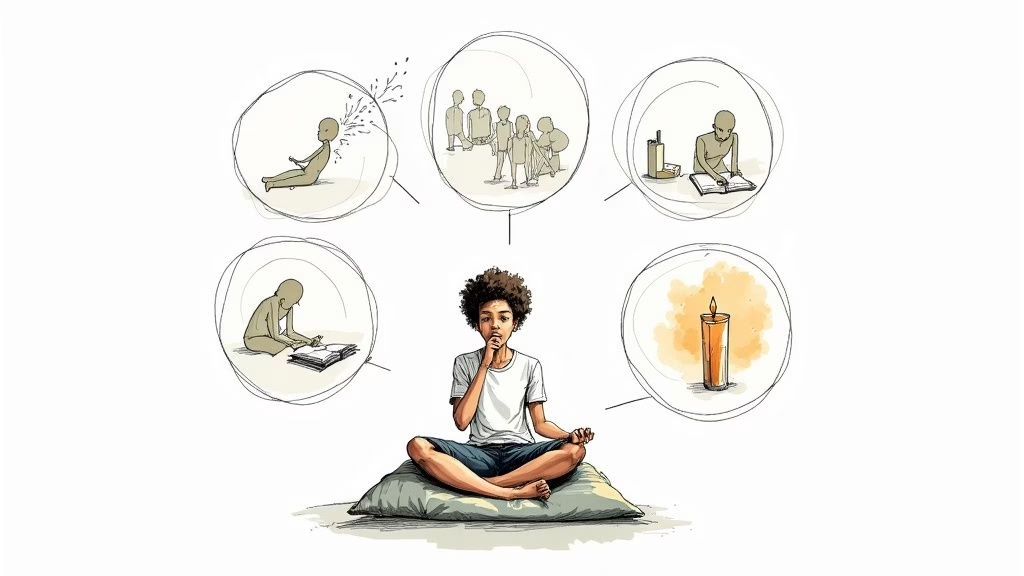Finding motivation isn't about waiting for a lightning bolt of energy to strike. It's about understanding what actually makes you tick and then learning how to use those forces to your advantage.
The real key is figuring out if you're working for an internal reward (like feeling proud of yourself) or an external one (like getting a good grade). Once you know that, you can build a strategy around it. Taking this proactive approach is your first step toward beating procrastination and actually hitting your goals, especially when it comes to motivation and school.
What Does Motivation Actually Feel Like?
When you imagine a "motivated person," you probably picture someone who’s always buzzing with energy and excitement. But that’s not really how it works. Motivation is way more nuanced. It’s not just one feeling, but a mix of different drives that push and pull you in different directions.
Getting a handle on these different "flavors" of motivation is a game-changer, especially when you’re trying to juggle school, friendships, and your own personal goals.
Sometimes, it’s a quiet feeling. Think about the satisfaction you get from finally solving a tough math problem, or the genuine interest that keeps you reading a book long after you’ve finished the required chapter. Other times, it's a much bigger push—like the urgency you feel to cram for a test to avoid failing. The first step to controlling these feelings is learning to recognize them.
The Different Types of Motivation
Motivation isn't one-size-fits-all. It can come from different sources and point you in different directions. Understanding these distinctions helps you figure out what truly drives you and how to harness it.
Let's break it down into three key pairs:
-
Intrinsic vs. Extrinsic (Conditional) Motivation: This is about where the drive comes from.
- Intrinsic motivation comes from within. You do something because you find it personally rewarding, enjoyable, or meaningful. The reward is the activity itself. Think of playing a video game for fun or learning guitar because you love music. This is the most powerful and sustainable type.
- Extrinsic motivation (often conditional) comes from the outside. You do something to earn a reward or avoid a punishment. Studying to get a good grade, doing chores for an allowance, or cleaning your room to avoid being grounded are classic examples. It's effective for short-term tasks but can sometimes kill the intrinsic joy of an activity.
-
Motivation Towards vs. Motivation Away From: This is about the direction of your drive.
- Motivation towards something good is driven by the desire to achieve a positive outcome. You're moving toward a goal, like training for a 5k to get a personal best or saving money for something you really want. This is an optimistic, empowering driver.
- Motivation away from something bad is driven by the need to avoid a negative consequence. You're moving away from a threat, like studying to avoid failing a class or driving the speed limit to avoid a ticket. It's a powerful short-term motivator but can be stressful and isn't great for long-term fulfillment.
-
Motivation for Self vs. Motivation for Others: This is about who you're doing it for.
- Motivation for self is centered on your own goals, values, and desires. It's about personal growth, self-satisfaction, and achieving something that matters to you.
- Motivation for others is driven by a desire to please, help, or meet the expectations of someone else—like parents, teachers, or friends. While this can be a powerful force (and isn't always bad), relying on it too heavily can lead you to pursue goals that aren't authentically yours, which can lead to burnout.
As you can see, the most sustainable drive comes from within (intrinsic), is directed toward a positive goal (toward), and is aligned with your own values (for self). While school will always have external pressures, the secret to staying driven is finding ways to connect those tasks to something you genuinely care about.
This chart drives the point home. When you look at what really moves the needle, it’s clear that setting a clear goal—something you are actively moving toward—provides the biggest boost. It gives you a target to aim for, turning vague wishes into a concrete plan of action.
The Real Reasons Your Motivation Disappears
That feeling when you have zero motivation? It’s rarely about being lazy.
Think of your motivation like your phone’s battery. You can’t always see what’s draining it, but behind the scenes, invisible forces are pulling its charge down to zero. Once it's empty, even opening a textbook feels like lifting a car.
The first step to figuring out how to find motivation again is to identify those drains. More often than not, they’re things you’re dealing with every single day—the pressure to crush your exams, the weight of a massive project, or just feeling completely overwhelmed.
The Cycle of School Stress and Procrastination
Academic burnout is a monster. The constant drumbeat of deadlines, pop quizzes, and expectations from parents and teachers can leave you feeling completely detached and exhausted. And that’s usually when procrastination shows up.
It's not that you don't care. Putting off that history paper gives you a quick hit of relief in a sea of stress. The only problem? That relief is temporary. As the deadline creeps closer, the stress roars back, bigger and louder than before, making the essay feel even more impossible.
The procrastination cycle is a trap: avoiding a task creates temporary relief, which leads to more guilt and anxiety, which makes you want to avoid the task even more. It’s a downward spiral that completely kills your drive.
This pattern does more than just hurt your grades. It chips away at your confidence. You start to see yourself as someone who "can't get things done," and pretty soon, that becomes a self-fulfilling prophecy, making the next project even harder to start.
The Deep Connection to Mental Health for Teens
Your motivation and your mental health are two sides of the same coin. When you’re wrestling with anxiety or just feeling low, your brain’s “get-up-and-go” system pretty much goes offline. In fact, a persistent lack of motivation is a classic sign of many mental health challenges teens face.
Think about it like this:
- Anxiety and Overwhelm: If you're freaked out about failing a test, that fear alone can be paralyzing. Your mind gets stuck in a loop of "what if" scenarios, leaving no mental energy left over to actually sit down and study.
- Feeling Low or Depressed: When you're down, things you used to love can feel pointless. This isn't a choice—it's a real shift in your brain chemistry that makes it hard to feel any sense of reward or accomplishment from your efforts.
- Social Pressure: The fear of being judged by friends or not measuring up to what everyone else is doing can be a massive weight on your shoulders. It makes you second-guess everything and sucks the personal drive right out of you.
It's so important to remember that a lack of motivation is not a character flaw. If you constantly feel empty or unable to get started, it could be a signal that you need more support. Reputable organizations like The Jed Foundation and NAMI (National Alliance on Mental Illness) have incredible, teen-focused resources for navigating these feelings.
Reaching out for support isn't giving up. It’s the strongest, bravest step you can take toward getting your well-being—and your drive—back on track.
Practical Ways to Build Motivation for School
Knowing what motivation is feels good, but it doesn't get the work done. The real challenge comes when you're staring at a blank document or a mountain of chemistry homework, and inspiration is nowhere in sight.
The goal isn't to wait for some magical burst of energy to strike. It's about building systems that create small sparks, tricking your brain into getting started and building a steady flame of momentum. This is where you learn how to find motivation when you feel like you have none.
Kickstart Your Brain with Small Wins
Procrastination loves big, intimidating tasks. When your brain sees "write entire essay," it immediately wants to nope out and scroll TikTok instead. The secret is to make the first step so ridiculously easy that you can’t talk yourself out of it.
That's the whole idea behind the "Two-Minute Rule." You break down any big task into a tiny action that takes less than two minutes.
- "Study for my history exam" becomes "Read one page of the textbook."
- "Write my English essay" becomes "Open a blank document and write a single sentence."
- "Clean my entire messy room" becomes "Put one thing back where it belongs."
Once you take that first tiny step, something funny happens. An object in motion tends to stay in motion. Getting over that initial wall of resistance is almost always the hardest part. Completing that tiny task gives your brain a little hit of dopamine, which makes it just a little bit easier to do the next thing, and then the next.
A lot of us delay work because we’re waiting for the “right mood” to strike. But motivation usually comes after you start, not before. The act of doing is what creates the feeling of wanting to do.
Engineer Your Environment for Focus
Your physical space has a huge impact on your mental state. Trying to grind out homework on your bed, surrounded by distractions, is like trying to swim upstream against a strong current. You’ve got to create an environment that sends a clear signal to your brain: it’s time to work.
A good study space isn't about having a fancy desk; it's about being intentional. It’s about minimizing friction and maximizing focus.
- Designate a Spot: Find one specific place—a corner of your room, a seat at the kitchen table—that is used only for schoolwork. When you sit there, your brain will start to associate that spot with focus.
- Remove Temptations: This is a big one. Put your phone in another room. Seriously. Use an app to block distracting websites. The less willpower you have to burn resisting distractions, the more you’ll have for your actual work.
- Organize Your Materials: Before you even start, make sure you have everything you need right there. A five-minute hunt for a highlighter is all it takes to completely derail your focus.
These small environmental tweaks really add up, making it way easier to get into a state of flow. When you master your surroundings, you make it easier to concentrate.
Parenting Tips: How to Support Your Teen’s Motivation
It can be incredibly frustrating to watch your teen drift without a sense of drive. Your first instinct is probably to step in—to push, set deadlines, and issue reminders about what’s at stake. But more often than not, this just creates a cycle of nagging and resentment that smothers whatever motivation was there to begin with.
The real goal is to shift your role from a manager to a supportive coach. It’s about creating an environment where your teen feels understood and empowered enough to build their own internal drive. This is a delicate balance, one that requires offering guidance while also stepping back to let them take ownership.
Foster Autonomy and Trust
One of the most powerful things you can do is give your teen a sense of control over their own life. When they feel like they have agency, they’re far more likely to develop intrinsic motivation—the desire to do something because they want to, not because they're being forced.
So, instead of issuing commands, try asking open-ended questions that spark their own problem-solving skills. For example, rather than saying, "You need to study for your math test," you could ask, "What’s your plan for the math test this week?" This simple switch shows you trust them to think for themselves.
A key to understanding how to find motivation is recognizing that it can't be forced from the outside. Lasting drive is built from within, fueled by a sense of purpose and personal ownership.
This approach validates their ability to handle their responsibilities. For more strategies on this, our guide on how to motivate a teenager dives deeper into fostering independence and better communication.
Celebrate Effort Over Outcomes
Our culture is obsessed with results—the final grade, the test score, the college acceptance letter. While these things matter, focusing only on the outcome creates intense pressure and a fear of failure, which are two of the biggest motivation killers out there.
Instead, make a conscious effort to praise the process. Acknowledge the hard work, the persistence, and the strategies they use to get there.
- Praise their resilience: "I know that history chapter was tough, but I'm really impressed with how you stuck with it."
- Acknowledge their strategy: "That was smart to start a study group for your science final."
- Focus on growth: "You've really improved your organizational skills this semester."
This shift helps your teen see that their effort is what truly matters, which in turn builds a resilient mindset that isn't derailed by setbacks. It teaches them that progress, not perfection, is the real goal. This isn't just a teen issue, either. Research on growth mindset by Dr. Carol Dweck shows that praising effort fosters persistence and a love of learning.
Mental Health Resources That Can Help
Let's get one thing straight: your motivation and your mental health are deeply connected. When you're feeling burned out, anxious, or just plain stressed, even the smallest tasks can feel like climbing a mountain. Trying to "power through" a lack of drive without addressing what's going on emotionally is like trying to drive a car on empty. You’re not going to get very far.
Recognizing that connection is a huge first step. The next is knowing that asking for help is one of the strongest, most strategic things you can do to get back in the driver's seat. You don’t have to figure this out alone. There are some incredible resources out there specifically for teens.
Where to Turn for Support
I know, finding the right help can feel like another overwhelming task. But a few organizations have done an amazing job of creating confidential, judgment-free spaces for young people.
Here are a few trusted places to start:
- The Jed Foundation (JED): This organization is all about protecting emotional health and preventing suicide for teens and young adults. Their website is packed with real-world advice on managing anxiety, depression, and school stress.
- National Alliance on Mental Illness (NAMI): NAMI is a powerhouse for advocacy, education, and support. They have programs and resources designed specifically for the mental health challenges teens face today.
- The Trevor Project: Focused on LGBTQ young people, they provide crisis intervention and suicide prevention services, including a 24/7 hotline and online chat.
- Teen Mental Health.org: This site is dedicated to providing science-based information to help teens and their families understand mental health and mental disorders.
Reaching out isn't a sign of weakness; it's a strategic move to refuel your emotional tank. Taking care of your mental health is the foundation that all lasting motivation is built on.
Tools for Your Mental Wellness Toolkit
Beyond organizations, there are everyday tools that can make a real difference in managing stress and getting your focus back. Simple practices like mindfulness can be surprisingly effective.
Apps like Calm or Headspace are great for this, offering guided meditations and quick exercises designed to quiet a racing mind, lower anxiety, and improve your ability to concentrate. Research from institutions like Johns Hopkins has shown that even a short period of daily mindfulness can help reduce symptoms of anxiety and depression.
Ultimately, a huge part of rebuilding motivation is tackling the negative self-talk that holds you back. Learning to reframe those thoughts is a genuine superpower. Taking some time to explore how to start overcoming limiting beliefs and rewriting your narrative can give you practical strategies to build a stronger, more empowering mindset.
How to Keep Your Motivation for the Long Run
Finding that initial burst of energy to start something new? That's the easy part. The real challenge is keeping that fire lit over weeks, months, or even years. Long-term motivation isn't about staying hyped up 24/7—that's a recipe for burnout. It's about finding a rhythm of effort and rest that keeps you moving forward.
The secret is ditching the all-or-nothing mindset. When you set super rigid goals, one missed day can feel like a total failure, making you want to quit altogether. Real, sustainable motivation is built on goals that can bend without breaking.
Build a System of Sustainable Habits
You can't rely on willpower alone. It's a finite resource, and it will eventually run out. A much smarter approach is to build systems and habits that make progress feel almost automatic.
This starts with changing how you measure success. Instead of obsessing over the final outcome—the A+ on the test, the championship win—learn to celebrate the process.
For example, don't just focus on the final grade. Keep a simple log of your study sessions. Seeing a streak of five days in a row, even if one of those days was just 15 minutes of review, gives you a powerful visual of your commitment. It proves you're showing up.
This also means learning to be kind to yourself. We all have off-days where focus feels like trying to catch smoke.
An off-day isn't a failure—it's a signal from your brain to rest, not to quit. True long-term success comes from listening to your body, recharging, and getting back to it when you're ready.
The Power of Community and Accountability
Trying to do it all on your own is tough, and frankly, it's not very effective. One of the most powerful tools for staying motivated is tapping into your community. When you share your goals with a friend you trust, a family member, or a mentor, you create a natural sense of accountability.
Just knowing someone else is in your corner can be the push you need on days when you’d rather do anything else. This doesn't have to be complicated:
- A weekly check-in text with a friend about progress on a big project.
- Study sessions with classmates where you work alongside each other.
- Sharing small wins with a parent who cheers for your effort, not just the final result.
This need for connection is universal. Research consistently shows that social support is a key factor in achieving long-term goals and maintaining well-being. By making your goals public, even to one other person, you increase your chances of success.
At the end of the day, motivation isn't something you find; it's a skill you build. By setting flexible goals, tracking your effort, and leaning on your people, you can cultivate a resilient drive that actually lasts.
If you're looking for personalized strategies to build lasting motivation and tackle your academic goals head-on, Andrew Petrillo Life Coaching can help. Discover how one-on-one coaching can provide the structure, support, and accountability you need to succeed. Book your free discovery call today at andrewpetrillolifecoaching.com.

























